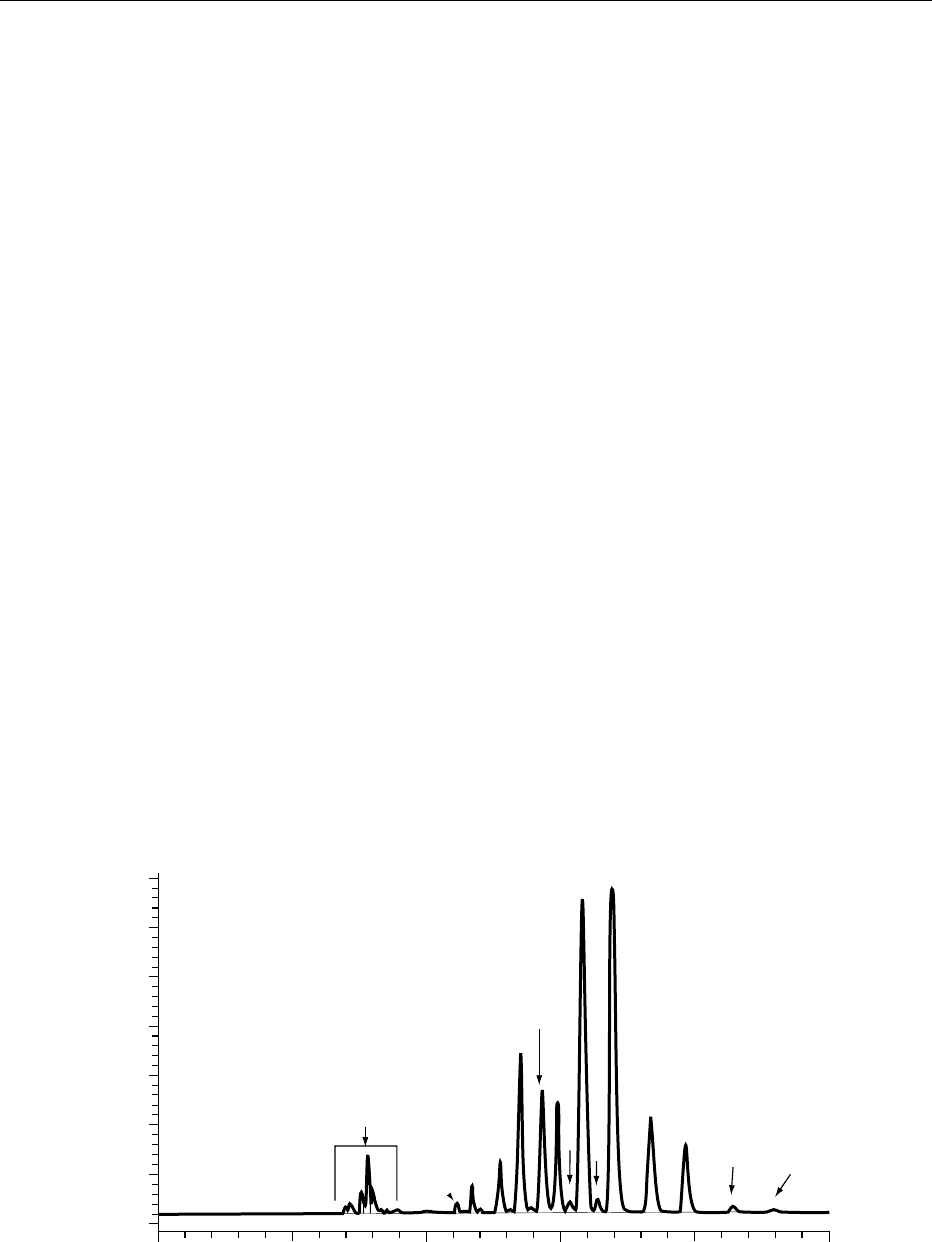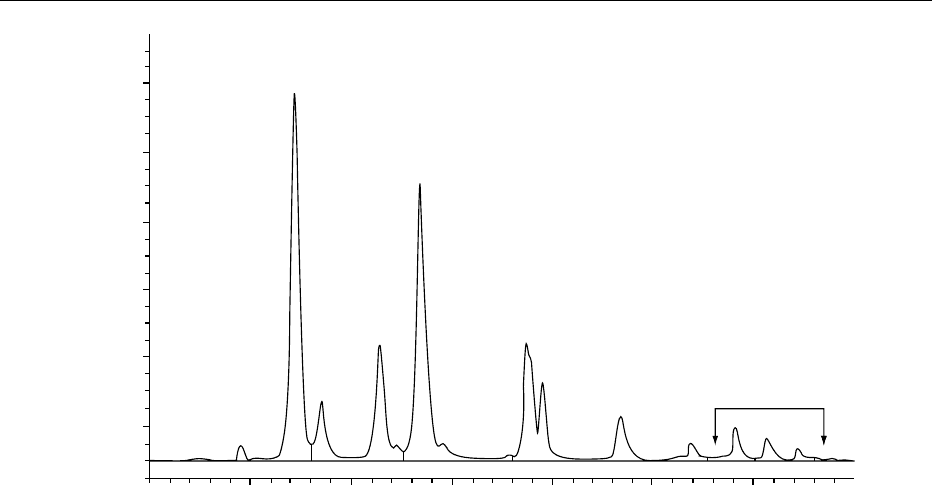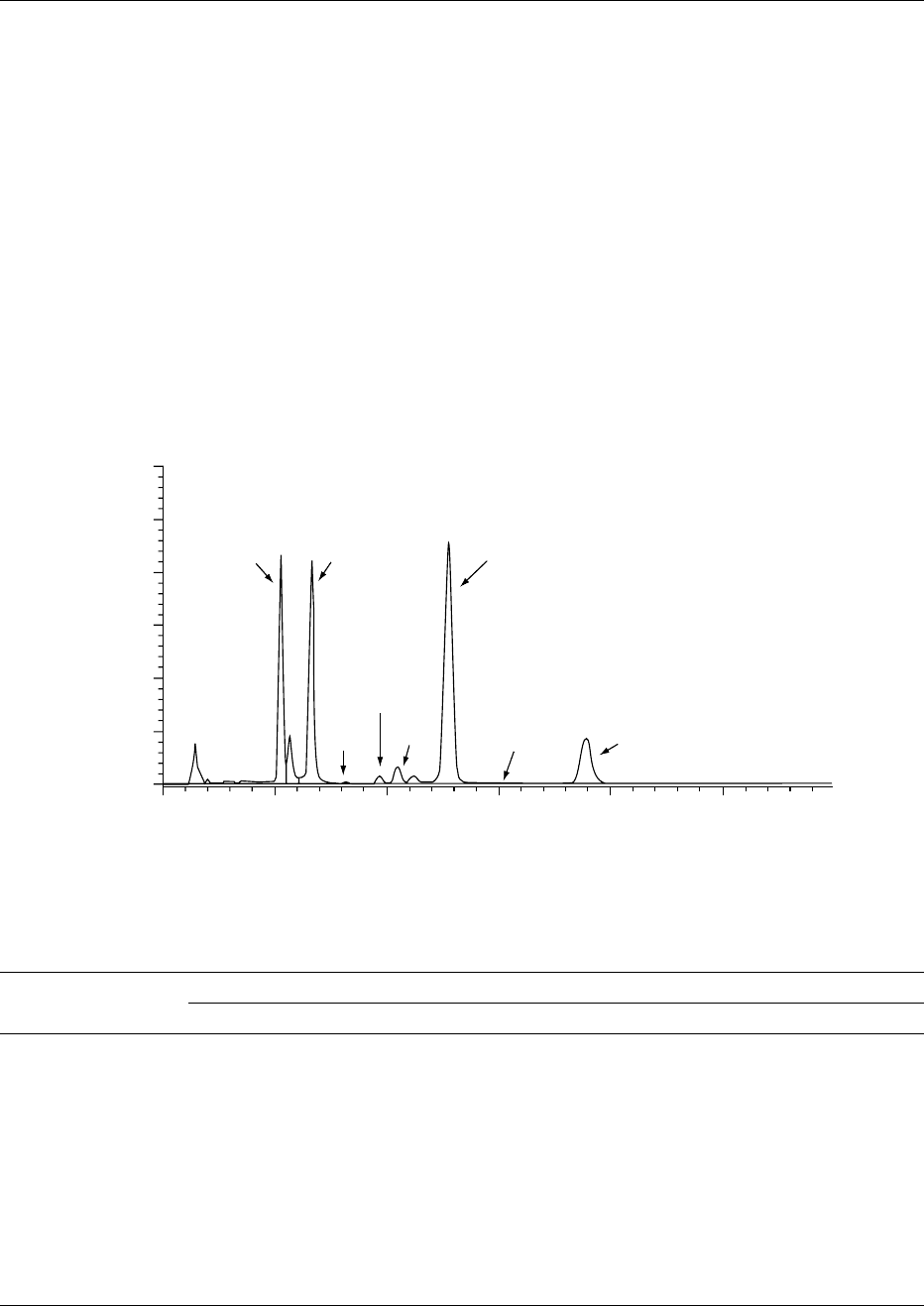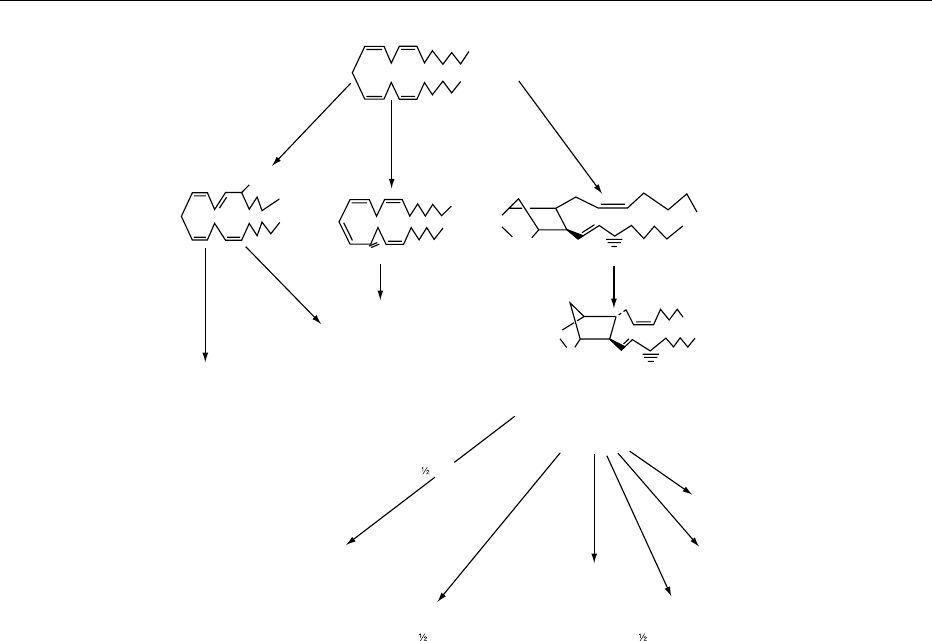Caballero B. (ed.) Encyclopaedia of Food Science, Food Technology and Nutrition. Ten-Volume Set
Подождите немного. Документ загружается.


each sample to a solvent ratio of 95%-A to 5%-B,
pumped for 15 min at 1.0 ml min
1
. This column
equilibration step and time are important for consist-
ent retention times and separations. An HPLC system
with an autosampler that will time this period
accurately is a great advantage.
0011 RP column packings are not tolerant of high
sample loadings and are sensitive to small amounts
of other solvents used to dissolve samples. Thus,
sample sizes should not exceed 100 mgin20mlof
solvent. If the sample solvent cannot be that used as
the initial mobile phase for HPLC, then its behavior
in modifying the column condition must be ascer-
tained. Chloroform should be avoided as it often
causes peak splitting, whereas alcohols and hexane
create solubility problems. Toluene is a suitable
general purpose solvent in this application. Typical
chromatography data are shown in Figure 1.
Argentation High-performance Liquid
Chromatography
0012 Vegetable fats used for confectionery production,
such as for chocolate, require fats with specific phys-
ical properties. Such a fat is cocoa butter (CB) and
any of the CB equivalents derived by blending of
native and fractionated fats of vegetable origin. The
specific melting properties and solid/liquid ratios
(measured by pulsed nuclear magnetic resonance
and plotted as solid fat curves) are created by the
presence of a high level (up to 90%) of ‘symmetrical’
monounsaturated TAG. This TAG has oleic acid (O)
at position 2 and a saturated fatty acid, palmitic (P)
or stearic (St), at positions 1 and 3, thus producing
POP-, POSt-, and StOSt-type TAGs. Perhaps the most
rapid method of obtaining quantitative evaluation of
such a fat is via argentation HPLC. In this technique,
the silver atoms form transient ‘complexes’ with the p
electrons of the unsaturated centers (double bonds).
Separation of TAG species depends upon the number
of double bonds, their geometry (whether cis or
trans), and the amount of hindrance caused to any
‘complex’ formation. Thus, monoenes separate from
dienes, from trienes, etc. ‘Complexes’ with trans
double bonds are less efficient than those with
cis double bonds and therefore also separate; trans
being relatively less polar than cis. Where there is
hindrance to ‘complex’ formation (due to fatty acid
position on the TAG), separation may also occur. For
instance, in StOSt, the double bond in oleic is more
hindered than in StStO, resulting in StOSt being
relatively less polar than StStO causing the two to
separate. Figure 2 shows a typical example of the
separation of TAG. (See Cocoa: Production, Prod-
ucts, and Use.)
0013To achieve the separations in Figure 2, a 20 cm
4 mm column of LiChrosorb Si-60, 5 mm silica
(Merck) coated with 5% silver nitrate, was used.
This packing is not available commercially but can
be prepared freshly for each column. The silver ni-
trate, in a foil-covered round flask, is dissolved in
acetonitrile and diluted with methanol. The silica is
slurried in this and the solvent carefully removed by
Palm oil
350
300
250
200
150
100
50
0
Response
01020304050
DGs
LnLnP
LnOM
LnOO
LnOP
PLnP
OOO
StLnO
PLnSt
PPP
POSt
PPSt
StOSt
POO
POP
Retention time (min)
fig0001 Figure 1 NARP-HPLC of refined, bleached, and deodorized Malaysian palm oil. St, stearic; P, palmitic; O, oleic; Ln, linoleic;
M, myristic; DGs, diacylglycerides.
5918 VEGETABLE OILS/Composition and Analysis

rotary evaporation, ensuring constant mixing. When
the packing is apparently dry, the last traces of solvent
are removed by heating the flask to 70
C under
vacuum for 10 min. This material is slurried in
chloroform for column packing and the column
packed to 28 MPa (4000 psi) with toluene for 45 min.
0014 The sample size can be up to 600 mgin30mlof
toluene. The three solvents for HPLC are:
.
0015 A ¼ toluene/hexane (1:1, v/v);
.
0016 B ¼ toluene/ethyl acetate (3:1, v/v);
.
0017 C ¼ toluene with 10 ppm formic acid.
0018 A concave solvent gradient is used from 8%-B to
90%-B in A over 28 min. The regeneration step is
very important and uses solvent C for 12 min
followed by 8%-B in A for 7 min. Solvent flow is
1.5 ml min
1
. Detection of the eluted TAG has to be
done by evaporative system detectors such as the
Tracor 945 (flame ionization type, not now commer-
cially available), or light-scattering instruments such
as the PL-ELS 1000 (Polymer Laboratories). It should
be noted that the quantitative behavior of the two
instrument types is different. The response curves of
the Tracor 945 are essentially linear, while those
of light-scattering instruments are curved and sig-
moid. Calibration is very important if reliable data
are to be obtained, and this should be part of a
written procedure. The analysis time is relatively
long with a turnaround time of about 40 min per
sample, but improvements have been made upon this.
Minor Components
0019Crude vegetable fats are usually at least 95%
TAG. After accounting for any FFA, other minor
components can be present, which can include toco-
pherols, carotenes, gums, waxes, polar lipids
(lecithins), unsaponifiable matter, chlorophyl pig-
ments, hydrocarbons, and mineral constituents
(present possibly as metal soaps of fatty acids).
Refer to individual constituents.
0020There are standard methods published by the
American Oil Chemists’ Society (AOCS) and the As-
sociation of Official Analytical Chemists (AOAC) for
the analysis of the above components. The procedures
are fully documented and tested and may be updated
at suitable periods, so they will not be reproduced
here. However, it is worth mentioning that some of
the older published methods have escaped improve-
ment, and more up-to-date procedures can often be
found.
0021For instance, tocopherols have traditionally been
estimated as a group, after isolation from the
nonsaponifiable fraction of an oil, by reaction
with a,a-dipyridyl and colorimetric analysis. How-
ever, it is known that the tocopherol composition
can aid the identification of a fat and also that
different tocopherol compositions lead to different
stabilities of a fat to oxidation. Accurate analysis
of individual tocopherol compositions can be readily
done by HPLC. Essentially, the extracted and dry
600
800
1000
1200
1400
1600
0 5 10 15 20 25 30
StStSt
StStO
StLSt
StLO
OOO
OOL
DAG
StOSt
StOO
Detector response (mV)
Retention time (min)
fig0002 Figure 2 Argentation HPLC of refined palm oil triacylglycerides. The peak labeling corresponds to fatty acids in the order of
occurrence on the glyceride: St, saturated (i.e., palmitic, stearic, arachidic); O, oleic; L, linoleic.
VEGETABLE OILS/Composition and Analysis 5919

fat is dissolved in the mobile phase solvent. A
15 cm 4mm column packed with 5- mm Chrome-
gasphere silica (E.S. Industries, Marlton, NJ) is used
with a fluorescence detector (e.g., Kontron SFM25
with a flow cell). Excitation is set at 294 nm and
emission at 325 nm. The HPLC system is isocratic
using a solvent of 3% THF in 2,2,4-trimethyl
pentane (iso-octane) as the mobile phase at a flow
of 1.5ml min
1
. The sample is applied via a 25- ml
loop and Rheodyne valve. Complete separation
of tocopherols and tocotrienols is achieved
(Figure 3). The column requires flushing with
10% methanol in chloroform every 200 samples to
remove any build-up of polar lipid material. Figure
3 shows a typical chromatogram from the analysis
of palm oil.
Authentication of Oils
0022The purity of composition of a natural vegetable oil
may be extremely important to the ultimate user. Fats
or oils can be among the most expensive ingredients
used in the manufacture of foods. Thus, there are
situations where, for reasons of unfortunate cross-
contamination or adulteration for profit, it becomes
important to know the authentic composition of a
natural oil. (See Adulteration of Foods: History and
Occurrence.)
0023The chemical composition of natural vegetable oils
is readily obtained by chromatographic analysis. In-
formation on structure can also be obtained by spe-
cific enzyme techniques, and minor components can
be analyzed either by chemical techniques or again by
50
0 5 10 15 20 25
100
150
200
250
300
350
α T
δ T
δ T3
β T
γ T
γ T3
β T3
α T3
Retention time (min)
Response
fig0003 Figure 3 HPLC analysis of palm oil tocotrienols and tocopherols (conditions are described in the text).
tbl0001 Table 1 Fatty acid composition of a range of rapeseed oils
Sample name Fattyacid (% composition)
12:0 14:0 16:0 16:1 18:0 18:1 18:2 18:3 20:0 20:1 20:2 22:0 22:1 24:0 24:1
German, Winter 0.1 4.2 0.3 1.9 59.7 20.2 8.9 0.5 2.0 0.1 0.3 1.5 0.1 0.2
UK, high yield 0.1 5.1 0.4 1.5 59.7 21.0 9.5 0.6 1.4 0.0 0.3 0.4 0.0 0.0
Denmark, Spring 0.0 4.7 0.3 1.4 57.5 21.7 10.9 0.5 1.6 0.1 0.4 1.0 0.0 0.0
France, Tapidor 0.1 4.7 0.3 1.9 59.4 21.0 9.5 0.5 1.5 0.0 0.4 0.7 0.0 0.0
USA, not known 0.0 4.0 0.2 2.1 61.2 20.0 9.5 0.6 1.5 0.1 0.3 0.5 0.0 0.0
China, high erucic 0.1 2.8 0.1 1.3 17.1 13.2 8.5 0.7 9.0 0.2 1.2 44.0 0.8 1.1
China, high erucic 0.1 1.8 0.3 1.7 16.2 12.0 8.3 0.8 9.0 0.2 1.3 46.0 0.7 0.6
Canada, not known 0.1 4.1 0.5 1.7 58.9 21.2 9.7 0.5 1.7 0.0 0.3 1.0 0.2 0.1
Europe, high erucic 0.1 4.0 0.3 1.0 18.5 14.5 11.0 0.8 6.5 0.8 0.5 41.0 1.0 0.0
UK, high yield 0.1 4.0 0.3 1.6 61.5 20.0 10.0 0.5 1.0 0.0 0.3 0.5 0.2 0.0
UK, not known 0.0 4.9 0.3 1.7 59.4 20.8 9.9 0.6 1.4 0.0 0.4 0.3 0.2 0.1
Laurical(GM)
a
39.93.92.70.11.830.111.09.10.20.80.40.10.00.00.0
High oleic, UK test crop 0.1 0.2 3.9 0.4 2.4 74.0 9.9 7.0 0.1 1.4 0.1 0.3 0.2 0.1 0.0
a
Genetically Modified Crop (trade name of Calgene).
5920 VEGETABLE OILS/Composition and Analysis

chromatography. All this information characterizes
the sample being analyzed, but does not necessarily
apply exactly to another oil of the same species from a
different part of the world. Also, it is important that
data be obtained via more than one technique, since
actual differences in oil composition may only
become apparent with certain techniques.
0024 Within a single species of plant, for instance rape-
seed, there can be a number of varieties. It is almost
certain that the oil composition of the varieties will
be different. This statement is even more important
now that genetic modification of oil composition is
being done. Also, if one variety is grown in different
environments, created either by countries or even by
areas of a single country, these situations can lead to
oils of variable composition. The differences may be
small or large, but they will provide statistical range
bands (with statistical means) within which any
particular oil composition might lie. This shows
that to authenticate a particular oil unambiguously,
there must be sufficient world data on the compos-
ition as measured by a number of techniques. Table 1
shows typical analytical data that we have found
for a range of rapeseed crops. Further data about
many vegetable oils are published in The Lipid
Handbook.
See also: Adulteration of Foods: History and
Occurrence; Carotenoids: Occurrence, Properties, and
Determination; Chromatography: High-performance
Liquid Chromatography; Gas Chromatography; Cocoa:
Production, Products, and Use; Contamination of Food;
Fats: Classification; Fatty Acids: Properties; Analysis;
Gums: Properties of Individual Gums; Phospholipids:
Properties and Occurrence; Tocopherols: Properties and
Determination; Physiology; Triglycerides: Structures and
Properties; Characterization and Determination
Further Reading
AOCS (1984) Recommended Practices, 3rd edn. Cham-
paign, IL: American Oil Chemists’ Society.
AOAC (1984) Official Methods of Analysis. Washington,
DC: Association of Official Analytical Chemists.
Christie WW (1982) Lipid Analysis, 2nd edn. Oxford: Per-
gamon Press.
Christie WW (1989) Gas Chromatography and Lipids – A
Practical Guide. Ayr, UK: The Oily Press.
Gunstone FD, Harwood JL and Padley FB (eds) (1986) The
Lipid Handbook. New York: Chapman & Hall.
Hammond E (1988) Flame ionisation detection for
the HPLC of lipids. Chromatography and Analysis 1:
7–9.
Hammond EW (1993) Chromatography for the Analysis of
Lipids. Boca Raton, FL: CRC Press.
Hammond EW (1998) Analysis – Tocopherols and Toco-
trienols. Lipid Technology 10: 86–88.
Jeffrey BSJ (1991) Silver-complexation liquid chromatog-
raphy for fast high-resolution separations of triacylgly-
cerols. Journal of the American Oil Chemists’ Society
68: 289–293.
Dietary Importance
J Dupont, United States Department of Agriculture,
Beltsville, MD, USA
This article is reproduced from Encyclopaedia of Food Science,
Food Technology and Nutrition, Copyright 1993, Academic Press.
Background
0001Vegetable oils are derived from oil seeds grown
mainly for their oil. The major food oils consumed
as cooking and salad oils are canola (rapeseed),
corn, cottonseed, olive, palm, palm kernel, coconut,
peanut, safflower, soya bean and sunflower. They are
all triacylglycerols that are liquid at room tempera-
ture, but differ greatly in fatty acid composition
(Table 1). They are classified as short-chain (C
6–8
),
medium-chain (C
10–12
), and long-chain (C
14–18
). The
plant oils may be saturated (completely hydrogen-
ated) or have one, two, or three double bonds of the
cis configuration. (See Fatty Acids: Properties.)
Energy Value
0002Long-chain acylglycerols provide 38 kJ g
1
, whereas
protein and carbohydrate provide 17 kJ g
1
. Because
of the difference in energy value of oils as compared
with the other energy-yielding nutrients, concentra-
tion in the diet is often expressed as a percentage of
energy (en%). Vegetable oils are highly digestible
(greater than 95%). They are hydrolyzed in the
gastrointestinal tract, yielding free fatty acids (FFAs)
and sn2-monoacylglycerols. By formation of bile mi-
celles, the FFAs and monoacylglycerols come into
contact with the mucosal cell membranes and diffuse
through the membrane. Within the mucosal cells,
they are reesterified to triacylglycerols. They are
made water-soluble by incorporation into chylomi-
crons in the mucosa.
0003Medium-chain fatty acids occur in triacylglycerols
(medium-chain triacylglycerols; MCT) of coconut
and palm kernel oils. The MCTs are much more
water-soluble than are long-chain triacylglycerols.
They are hydrolyzed and enter the mucosal cells
but are partially transported as FFAs in the portal
circulation.
0004Chylomicrons and albumin-bound fatty acids are
transported to the liver, adipose tissue, and other
organs. In the process, chylomicrons are hydrolyzed
VEGETABLE OILS/Dietary Importance 5921

by the action of lipoprotein lipase, and the fatty acids
enter the cells by diffusion and are reesterified to
triacylglycerols. During fasting, the triacylglycerol
fatty acids are released from adipose tissue by hy-
drolysis for use as energy. Fatty acids that enter
the liver are resecreted as very-low-density lipopro-
teins, which are hydrolyzed similarly to chylomi-
crons, yielding low-density lipoproteins (LDLs),
which are taken up by tissues via a receptor-mediated
process. The LDLs are hydrolyzed to yield fatty
acids for energy or reesterification and storage.
(See Lipoproteins.)
0005 Fatty acids are used for energy production in the
mitochondria and peroxisomes of cells. Saturated
fatty acids (SFAs) are oxidized by b oxidation to
yield acetyl coenzyme A (acetyl CoA), which enters
the tricarboxylic acid cycle. Unsaturated fatty acids
require two more enzymatic steps that are needed for
SFAs to change the existing double bonds from cis to
trans and to move them from a g to a b position. Even
so, oxidation of C18:2 n-6 is more rapid than that of
C18:1 n-9. Medium-chain triacylglycerol acids are
preferentially oxidized by peroxisomes rather than
mitochondria. Some of the acetyl CoA produced is
oxidized to hydrogen peroxide, which requires cata-
lase for dismutation to water and oxygen, yielding
heat. This reduces the yield of these fatty acids to
less than the 37.66 kJ g
1
assumed for fats in general.
(See Fatty Acids: Metabolism; Dietary Importance.)
Essential Fatty Acids
0006 Vegetable oils generally have a relatively high con-
centration of polyunsaturated fatty acids (PUFAs)
(Table 1). Exceptions are coconut, palm, and palm
kernel oils, which are primarily saturated, and olive
and canola oils, which have relatively less PUFAs and
more monounsaturated fatty acids. The most abun-
dant PUFA is linoleic acid (C18:2 n-6), with canola
and soya oils having appreciable concentrations of
a-linolenic acid (C18:3 n-3). Because these fatty
tbl0001 Table 1 Percentage fatty acid composition of refined vegetable oils
Oil Fattyacid
a
6:0 8:0 10:0 12:0 14:0 16:0 16:1 n- 7 18: 0 18:1 n-9 18:2 n-6 18:3 n - 3 20:1 20:4 n - 6 22:1
Canola
b
4 2 55 26 10 2
Rapeseed, LEAR
c
4.8 0.5 1.6 53.8 22.1 11.1 1.0 0.1
Soya bean 0.1 10.3 0.2 3.8 22.8 51.0 6.8 0.2
Corn 10.9 1.8 24.2 58.0 0.7
Olive 11.0 0.8 2.2 72.5 7.9 0.6 0.3
Cottonseed 0.8 22.7 0.8 2.3 17.0 51.5 0.2 0.1
Safflower 4.8 1.3 75.3 14.2
Linseed 5.3 4.1 20.2 12.7 53.3
Palm 0.1 1.0 43.5 0.3 4.3 36.6 9.1 0.2 0.1
Palm kernel 0.2 3.3 3.7 47.0 16.4 8.1 2.8 11.4 1.6
Coconut 0.6 7.5 6.0 44.6 16.8 8.2 2.8 5.8 1.8
Peanut 0.1 9.5 0.1 2.2 44.8 32.0 1.3
a
Number of carbons: number of double bonds, location of distal (from n or o) double bond.
b
From Canola Council of Canada (1987) Canola Oil^Properties and Performance. Publication No. 60. Winnipeg: Canola Council of Canada.
All other data from USDA (1979) Composition of Foods. Agriculture Handbook 8-4. Washington, DC: US Department of Agriculture.
c
Low-erucic-acid rapeseed oil.
tbl0002Table 2 Relationship between dietary linoleic acid and
biological effects
Dietaryconcentration
oflinoleic acid (en%)
Reported biological effects
0
8
>
>
>
>
>
>
>
>
>
>
>
>
>
>
>
<
>
>
>
>
>
>
>
>
>
>
>
>
>
>
>
:
Rat: dermatitis, growth retardation,
infertility, cellular and humoral immune
system defects
Human: dermatitis
1 Deficient Rat: increase in triene: tetraene ratio to
0.4, decrease in eicosanoid production
Mouse: immune system impaired, plaque
formation
Human: increase in triene: tetraene ratio to
0.4, decrease in clotting time
2–3
8
>
>
>
>
>
>
>
>
>
>
>
>
>
>
>
<
>
>
>
>
>
>
>
>
>
>
>
>
>
>
>
:
Rat: maximal amount of C20:4 n-6 in
cellular lipids, increased eicosanoid
production
Mouse: normal plaque formation
Saturation Human: increased plasma cholesterol,
decrease in triene: tetraene ratio to 0.1
4 Rat, guinea-pig, mouse: normal mitogenic
response
5 DMBA rat: mammary cancer
8 Human: decreased plasma cholesterol
10
8
>
>
>
>
>
>
<
>
>
>
>
>
>
:
Rodents: delayed hypersensitivity
normalized
NMU rat: mammary neoplasia
Excess Guinea-pig: decreased mitogenic
response
15 Rat: prostatic neoplasia, rat colon cancer
5922 VEGETABLE OILS/Dietary Importance

acids (1) cannot be synthesized by animal cells and
(2) have essential metabolic functions, they are
deemed dietary essential fatty acids. Table 2
summarizes current knowledge of the effects of dif-
ferent dietary levels of linoleic acid. (See Essential
Fatty Acids.)
0007 Linoleic acid is a component of ceramides,
which are necessary to maintain the transdermal
water barrier of the epidermis. It is the precursor
by elongation and desaturation (Figure 1) of arachi-
donic acid (C20:4 n-6). Arachidonate is the precursor
of the eicosanoids: prostaglandins, thromboxanes,
prostacyclin, and leukotrienes (Figure 2). The
eicosanoids are autocrine and paracrine factors,
which are physiologically active at concentrations of
pico- and nanograms. They are required for functions
of the cardiovascular, renal, gastrointestinal, immune,
and reproductive systems. (See Prostaglandins and
Leukotrienes.)
0008Many studies indicate that essential fatty acids
are necessary for normal immune function. Essential
fatty acid deficiency impairs B- and T-cell-mediated
responses. These impairments are normalized by
inclusion of essential fatty acids in the diet. Most
studies have used rodents, and the results cannot be
readily extrapolated to humans because the
immune systems of different species respond differ-
ently to dietary fat alterations. (See Immunology
of Food.)
0009a-Linolenic is the precursor for eicosapentaenoic
acid (C20:5 n-3) and docosahexaenoic acid (C22:6
n-3) that are required for brain and retinal develop-
ment and function in animals.
Vitamin E
0010The vegetable oils that contain high concentrations
of PUFA generally contain appreciable quantities of
a- and g-tocopherols (vitamin E) (Table 3). Vitamin E
is a membrane-bound, lipophilic antioxidant closely
associated with arachidonic acid in the membrane.
Vitamin E may protect membranes by trapping
lipid peroxyl free radicals produced from PUFA
under conditions of oxidative stress. (See Toco-
pherols: Physiology.)
n-9
Stearate
Oleate g -Linolenate
∆9D
∆5D
∆5D
∆5D
∆4D
∆4D
Di-homo-g -
linolenate
Eicosapentaenoate
Arachidonate
eicosatetraenoate
Eicosatrienoate
E
E
E
EE
E
∆6D ∆6D
Linoleate a-Linolenate
n-6 n -3
18:3 (n-3)18:2 (n-6)18:0
18:1 (n-9)
20:2 (n-9)
20:3 (n-9)
22:3 (n-9)
22:4 (n-6)
22:5 (n-6)
Docosahexaenoate
22:6 (n-3)
20:5 (n-3)
20:3 (n-6)
20:4 (n-6)
22:5 (n-3)
20:4 (n-3)
18:3 (n-6) 18:4 (n-3)
fig0001 Figure 1 Families of fatty acids formed from C
18
precursors by
desaturation (D) and elongation (E). The n-9 pathway is exhibited
in mammals only when there is insufficient n-6 present in the
diet. Reproduced from Vegetable Oils: Dietary Importance, En-
cyclopaedia of Food Science, Food Technology and Nutrition,
Macrae R, Robinson RK and Sadler MJ (eds), 1993, Academic
Press.
tbl0003Table 3 Vitamin E content of fats and oils (mg per 100 g)
a
Oil or fat a-Tocopherol g-Tocopherol Total
b
Butter 1.76 + 0.41 0 1.76
Coconut Trace Trace
Corn 11.28 + 6.25 50.76 + 19.00 62.04
Cottonseed 32.46 + 13.10 29.91 + 13.76 62.37
Lard 1.20 0.70 1.90
Olive 7.94 + 6.58 Trace 7.94
Palm 22.79 + 2.86 28.26 + 1.06 51.05
Peanut 15.12 + 4.41 23.20 + 6.90 38.32
Rapeseed 25.82 + 8.06 30.01 + 12.73 55.83
Safflower 39.23 + 3.74 15.76 + 4.40 54.99
Sesame 17.62 + 5.69 32.86 + 5.46 50.48
Soya bean 10.25 + 5.63 50.48 + 20.75 60.73
Sunflower 48.70 5.10 53.80
a
Data are expressed as the mean plus or minus the standard deviation and
are from Dupont J, White PJ, Carpenter MP et al. (1990) Food uses and
health effects of corn oil. Journal of the American College of Nutrition 9:
438–470.
b
Sum of a- and g -tocopherol.
VEGETABLE OILS/Dietary Importance 5923

Cardiovascular Effects
0011 Saturated fatty acid in the diet raises plasma choles-
terol, and PUFA lowers it. Many published studies
indicate that lowering plasma cholesterol decreases
the population risk of heart disease. Levels of LDL-
cholesterol are lowered by reducing SFA intake; the
effect of concomitantly increasing PUFA is greater
than that of merely reducing the SFA. Vegetable oils
that increase the percentage of PUFA in the diet con-
tribute to reducing plasma cholesterol. Enrichment of
the diet with PUFA reduces blood pressure and has
favorably influenced the progression of diabetic
angiopathy in adult-onset diabetes mellitus. (See
Cholesterol: Role of Cholesterol in Heart Disease;
Coronary Heart Disease: Antioxidant Status.)
Oncogenic Aspects
0012 Human surveys and animal experimentation support
a role for total fat (excess energy) intake in the devel-
opment of cancer, particularly in mammary tissue.
The impact of linoleic acid intake on mammary
and pancreatic tumorigenesis is not documented in
human studies, nor is its impact on colon carcinogen-
esis as in animal studies. A hypothesis arising from
human studies is that it is displacement of protective
foods such as fruits, vegetables, pulses, and cereals
from the diet by fat-rich foods that is detrimental,
rather than any direct effects of fat in the diet. (See
Cancer: Diet in Cancer Prevention; Colon: Cancer of
the Colon; Margarine: Dietary Importance.)
See also: Cancer: Diet in Cancer Prevention; Cholesterol:
Role of Cholesterol in Heart Disease; Colon: Cancer of
the Colon; Coronary Heart Disease: Antioxidant Status;
Essential Fatty Acids; Fatty Acids: Properties;
Metabolism; Dietary Importance; Immunology of Food;
Lipoproteins; Margarine: Dietary Importance;
Prostaglandins and Leukotrienes; Tocopherols:
Physiology
Further Reading
Dupont J (1990) Lipids. In: Brown M (ed.) Present Know-
ledge of Nutrition, 6th edn, pp. 56–66. Washington,
COOH
COOH
COOH
PETE
OOH
COOH
O
2
O
2
O
2
O
2
O
O
O
O
OH
OOH
2H
12-HETE
5-HETE
LEUKOTRIENES
GSH
2H
A
2
PGF
2α
Thromboxane A
2
MDA
Prostacyclin
12 OH 17:30[HHT]
+
PGE
2
PGD
2
ENDOPEROXIDE
(PGH
2
)
2H
5
12
COOH
OOH
Leucocyte
lipoxygenase
Blood
platelet
lipoxygenase
Cyclooxygenase
t
= 5 min
t = 30 s t = 10 min
fig0002 Figure 2 Eicosanoid synthesis from arachidonate. HETE, hydroxyeicosatetraenoic acid; PETE, peroxyeicosatetraenoic acid; PG,
prostaglandin; GSH, glutathione; MDA, malondialdehyde; TX, thromboxane; PGI
2
, prostacyclin. Reproduced from Vegetable Oils:
Dietary Importance, Encyclopaedia of Food Science, Food Technology and Nutrition, Macrae R, Robinson RK and Sadler MJ (eds), 1993,
Academic Press.
5924 VEGETABLE OILS/Dietary Importance

DC: International Life Sciences Institute Nutrition Foun-
dation.
Dupont J, White PJ, Carpenter MP et al. (1990) Food uses
and health effects of corn oil. Journal of the American
College of Nutrition 9: 438–470.
Dupont J, White PJ and Feldman EB (1991) Saturated
and hydrogenated fats in food in relation to health.
Journal of the American College of Nutrition 10:
577–592.
VEGETABLES OF TEMPERATE CLIMATES
Contents
Commercial and Dietary Importance
Cabbage and Related Vegetables
Leaf Vegetables
Oriental Brassicas
Carrot, Parsnip, and Beetroot
Swede, Turnip, and Radish
Miscellaneous Root Crops
Stem and Other Vegetables
Commercial and Dietary
Importance
S K Roy and A K Chakrabarti, Indian Agricultural
Research Institute, New Delhi, India
Copyright 2003, Elsevier Science Ltd. All Rights Reserved.
Introduction
0001 Vegetables are considered as protective foods supply-
ing carbohydrate, protein, minerals, vitamins, and
crude fiber, which are essential ingredients of a bal-
anced diet. In addition to their role in nutrition, they
increase the attractiveness and palatability of a diet
by providing sensory appeal through their variety of
color and flavor.
General Nutrient Composition
0002 Vegetables in general, except for a few, are not con-
sidered to be the primary source of carbohydrate,
protein, and fat. However, some of them with storage
roots and tubers are rich in carbohydrate, particularly
starch, in amounts comparable to the cereal crops,
and the leguminous vegetables supply as much as
14% protein, while dry seeds supply still more. The
lipid content in most vegetables is less than 0.1%.
Most leafy vegetables and root crops are rich in
minerals. Carrot and leafy vegetables are also high in
carotene (provitamin A) and vitamin C. Deep-green
leafy vegetables are rich in folate (folic acid). Besides,
there are some trace elements required by the body
like copper, manganese, and zinc, which act as enzyme
cofactor. These are found in appreciable quantities
in cole crops, roots crops, and some leafy vegeables.
(See Carotenoids: Physiology.)
0003The nutrient content of a vegetable is dependent
on several factors. The environment in which the
crop is grown, such as temperature, light, moisture,
nutrients, and physical and chemical properties of
the soil, plays an important role. The amount of
nutrient can vary with variety, cultural practices,
stage of maturity, postharvest handling, and storage
conditions. Once the vegetable is harvested, its com-
position goes on changing as a result of physio-
logical and biochemical activities, which are
natural processes.
0004In addition, methods of cooking also influence the
nutrient content of vegetables; in particular, leaching
losses and oxidative changes are considered as deteri-
orative processes. The composition of the same
vegetable grown in different parts of the world is
so different that it becomes difficult to use a general
table of composition as a source of precise informa-
tion of nutritive value of the crop used in the diet.
However, such a table gives an estimate of the prox-
imate composition of the nutrients. The nutrient com-
position of individual vegetables is given in Tables 1
and 2, and trace elements in Table 3. Refer to indi-
vidual nutrients.
VEGETABLES OF TEMPERATE CLIMATES/Commercial and Dietary Importance 5925

Dietary and Commercial Importance
0005 Apart from major nutrients, vitamins, and minerals,
there are some phytochemicals present in vegetables
which have been indicated by rapidly growing scien-
tific evidence to play a major role in promoting health
and in preventing certain diseases. These chemicals
have often been referred to as phytonutrients or
phytoceuticals. Besides, there are some key micro-
nutrients, flavor compounds, and toxic substances
found in vegetables which deserve attention.
Phytoceuticals
0006 Phytoceuticals can be grouped on the basis of their
therapeutical activities or their physical and chemical
constitution. Some of these groups are bioflavonoids,
phenols, phytosterols, thiols, indoles, glucosinolates,
and organosulfur compounds.
0007Bioflavonoids are one of the largest groups of sec-
ondary plant metabolites found in several vegetables.
They have been reported to increase the effectiveness
of vitamin C and are recognized as potent antioxi-
dants. Together with vitamin C they strengthen the
capillaries and protect the body from free radicals.
They are also antiviral and antiinflammatory. Some
of the important bioflavonoids identified from
vegetables are quercetin, kaempferol, myricetin, and
luteolin. There are reports which suggest that querce-
tin (found in onion) can inhibit the growth of several
types of cancer cells, including breast cancer, ovarian
cancer, and leukemia.
0008The higher content of phenols has been linked to
disease resistance in plants. Phenols have also been
found to protect our body from oxidative damage
caused by free radicals. Some tropical root vegetables
like yam, elephant-foot yam, and other vegetables
like green banana and eggplant are rich in phenols.
0009Phytosterols occur in most plants, especially in the
seeds of green and yellow vegetables. Phytosterols
prevent the absorption of cholesterol and facilitate
its excretion from the body. There are some reports
which suggest that phytosterols prevent the develop-
ment of tumors in breast, colon, and prostate glands.
0010Thiols are important sulfur compounds found
in brassicaceous vegetables like broccoli, cabbage,
cauliflower, and kale, and in garlic. There is strong
evidence to suggest that these compounds can pre-
vent cancers of colon, rectum, and breast. Indoles
found in Brassicas bind chemical carcinogens and
activate detoxification enzymes, mostly in the gas-
trointestinal tract.
0011Glucosinolates, which are secondary plant metab-
olites, found mostly in cole crops and other Brassicas,
are powerful activators of enzymes in the liver which
detoxify carcinogens.
0012There are several organosulfur compounds found
in onion and garlic which appear to possess anti-
microbial properties and offer protection against
cardiovascular diseases.
Key Micronutrients
0013Vegetables are the major source of vitamins and min-
erals essential for our body. They are the most im-
portant source of vitamin A; deficiency of vitamin A
in the diet causes blindness. Vitamin A is essential for
growth, bone development, vision, reproduction, and
functioning of the immune system. Vitamin A is syn-
thesized in our body from carotene which is present
in abundance in green leafy vegetables, carrot,
pumpkin, squash, melon, and tomato. Of about 600
carotenoids identified from natural sources, less than
tbl0001 Table 1 Macronutrient composition of temperate vegetables
per 100 g edible portion
Crop Energy
(kcal)
Moisture
(g)
Protein
(g)
Fat
(g)
CHO
(g)
Artichoke 79 77.3 3.6 0.1 16.0
Asparagus 26 91.7 2.5 0.2 5.0
Broad bean 48 85.4 4.5 0.1 7.2
Brussels sprout 45 85.2 4.9 0.4 8.3
Cabbage 24 92.4 1.3 0.2 5.4
Cardoon 10 94.0 0.7 0.1 1.8
Carrot 42 82.2 1.1 0.2 9.7
Cauliflower 27 91.0 2.7 0.2 5.2
Celery 17 94.1 0.9 0.1 3.9
Chicory leaf 13 92.0 1.7 0.3 1.1
Endive 11 95.0 1.3 0.2 1.2
Garden beet 43 87.7 1.7 0.1 8.8
Garlic 30 62.0 6.3 0.1 29.8
Kale 53 82.7 6.0 0.8 9.0
Knol khol 29 90.3 2.0 0.1 6.6
Knol khol green 43 86.7 3.5 0.4 6.4
Leek 77 78.9 1.8 0.1 17.2
Lettuce 14 95.1 1.2 0.2 2.5
Onion 50 86.6 1.2 0.1 11.1
Onion stalk 41 87.6 0.9 0.2 8.9
Parsley 16 90.0 2.2 0.3 1.3
Parsnip 53 81.0 1.2 0.3 11.6
Pea 84 78.0 6.3 0.4 14.4
Potato 97 74.7 1.6 0.1 22.6
Radish 17 94.4 0.7 0.1 3.4
Rutabaga 46 87.0 1.1 0.1 11.0
Spinach 26 90.7 3.2 0.3 4.3
Spinach beet 46 86.4 3.4 0.8 6.5
Sprouting broccoli 32 89.1 3.6 0.3 5.9
Swiss chard 16 92.0 1.8 0.2 1.5
Turnip root 29 91.6 0.5 0.2 6.2
Turnip green 67 81.9 4.0 1.5 9.4
Sources: Gopalan C, Sastri BVR, Balasubramanian SC, Rao BSN,
Deosthale YG and Pant KC (1999) Nutritive Value of Indian Foods.
Hyderabad: National Institute of Nutrition; Watt BK and Merril AL (1963)
Composition of Foods ^ Raw, Processed, Prepared. Agricultural Handbook
No. 8. Washington, DC: USDA.
CHO, carbohydrate.
5926 VEGETABLES OF TEMPERATE CLIMATES/Commercial and Dietary Importance

10% are precursors of vitamin A. In human beings,
b-carotene, a-carotene, and cryptoxanthin are con-
verted to vitamin A, whereas lycopene (present in
tomato) and lutein are not. Most important is
b-carotene. Some of the carotenoids are powerful
antioxidants and have been shown to offer protection
against breast, lung, uterine, prostate, and colon
cancers.
0014Vitamin C (ascorbic acid) is essential for wound
healing, immune response, and allergic reaction. It
is a powerful antioxidant and is found in many
vegetables like broccoli, cauliflower, Brussels sprout,
tomato, pepper, and potato. It protects our body by
scavenging free radicals.
0015Vitamin E is also an antioxidant which prevents
peroxidation of polyunsaturated fatty acids in our
body. Increased intake of vitamin E is believed to
reduce the incidence of heart attack. The combined
action of vitamin E, C, and A has been reported to
tbl0003 Table 3 Important trace elements (mg per 100 g) of some
temperate vegetables
Crop Cu Mn Zn
Beetroot 0.29 0.19 0.91
Brussels sprouts 0.20 0.18 0.30
Cabbage 0.02 0.18 0.30
Carrot 0.10 0.16 0.36
Cauliflower 0.13 0.10 0.40
Knol khol 0.05 0.11 0.24
Onion 0.18 0.28 0.46
Onion stalk 0.45 0.74 2.29
Pea 0.23
Potato 0.16 0.13 0.55
Radish 0.40
Spinach 0.10 0.56 0.30
Source: Gopalan C, Sastri BVR, Balasubramanian SC, Rao BSN,
Deosthale YG and Pant KC (1999) Nutritive Value of Indian Foods.
Hyderabad: National Institute of Nutrition.
tbl0002 Table 2 Micronutrient composition of temperate vegetables per 100 g edible portion
Crop Vitamins Minerals
A
(IU)
Thiamin
(mg)
Riboflavin
(mg)
Niacin
(mg)
Folic acid
(mg)
Ascorbic acid
(mg)
Ca
(mg)
P
(mg)
Fe
(mg)
Artichoke 62 0.23 0.01 – – 0 120 100 2.3
Asparagus 900 0.18 0.20 1.5 109 33 22 62 1.0
Broad bean 15 0.08 – 0.8 – 12 50 64 1.4
Brussels sprout 550 0.10 0.16 0.9 49 102 36 80 1.5
Cabbage 130 0.05 0.05 0.3 32 47 49 29 0.4
Cardoon 120 0.02 0.03 0.3 – 2 70 23 0.7
Carrot 11000 0.06 0.05 0.6 15 8 37 36 0.7
Cauliflower 60 0.11 0.10 0.7 22 78 25 56 1.1
Celery 240 0.03 0.03 0.3 7 9 39 28 0.3
Chicory leaf 4000 0.06 0.10 0.5 – 24 100 47 0.9
Endive 2500 0.07 0.08 0.4 47 8 42 30 2.0
Garden beet 0 0.04 0.09 0.4 – 10 18 55 1.0
Garlic Trace 0.06 0.23 0.4 – 13 30 310 1.3
Kale 10000 0.16 0.26 2.1 70 186 249 93 2.9
Knol khol 20 0.06 0.04 0.3 – 66 41 51 0.5
Knol khol green 6924 0.25 – 0.3 – 157 740 50 13.3
Leek 30 0.23 – – – 11 50 70 2.3
Lettuce 900 0.06 0.06 0.3 25 8 35 26 2.0
Onion Trace 0.08 0.01 0.4 11 11 47 50 0.7
Onion stalk 993 0.05 0.03 0.3 14 17 50 50 7.4
Parsley 5200 0.08 0.11 0.7 38 90 125 40 2.0
Parsnip 0 0.09 0.05 0.7 – 17 40 69 0.7
Pea 640 0.35 0.14 2.9 25 27 26 116 1.9
Potato 40 0.10 0.01 1.2 7 17 10 40 0.7
Radish 5 0.06 0.02 0.5 7 15 35 22 0.4
Rutabaga 580 0.07 0.07 1.1 5 33 66 39 0.4
Spinach 8100 0.10 0.20 0.6 123 51 93 51 3.1
Spinach beet 5862 0.26 0.56 3.3 60 70 380 30 16.2
Sprouting broccoli 2500 0.10 0.23 0.9 54 113 103 78 1.1
Swiss chard 3300 0.04 0.09 0.4 42 30 51 46 1.8
Tumip green 15691 0.31 0.57 5.4 42 180 710 60 28.4
Turnip root 0 0.04 0.04 0.5 4 43 30 40 0.4
Source: Gopalan C, Sastri BVR, Balasubramanian SC, Rao BSN, Deosthale YG and Pant KC (1999) Nutritive Value of Indian Foods. Hyderabad: National
Institute of Nutrition; Watt BK and Merril AL (1963) Composition of Foods ^ Raw, Processed, Prepared. Agricultural Handbook No. 8. Washington, DC: USDA.
VEGETABLES OF TEMPERATE CLIMATES/Commercial and Dietary Importance 5927
